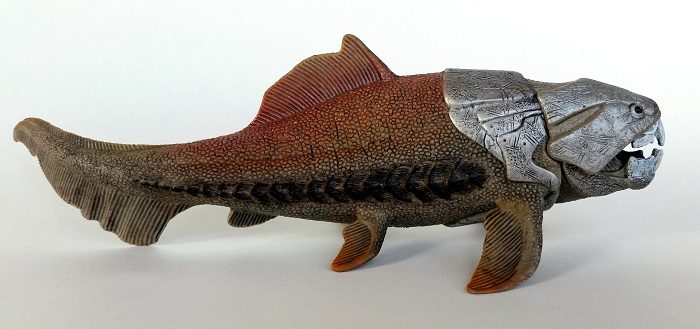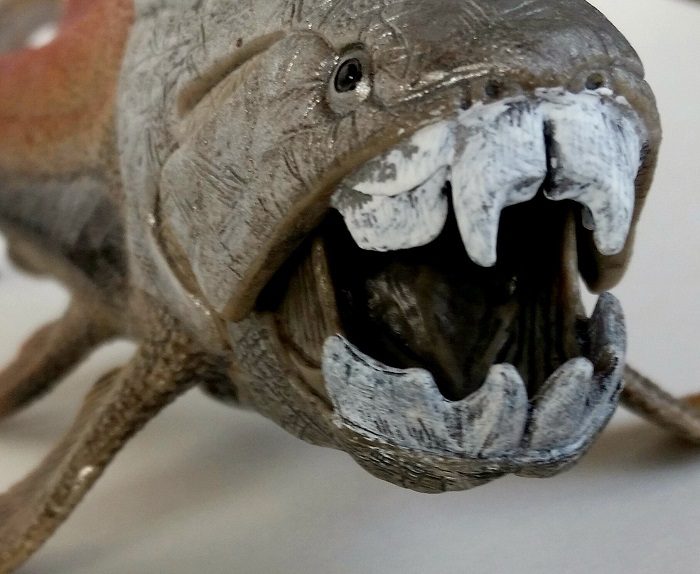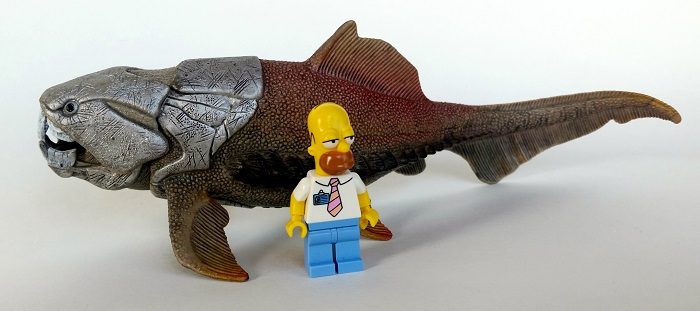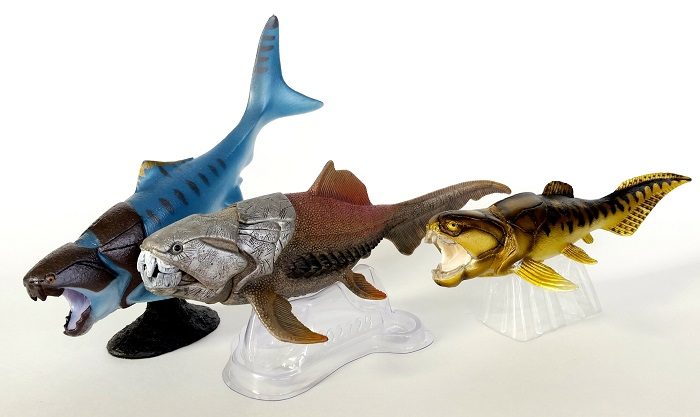Review and photos by Tim Sosa, edited by Suspsy
It isn’t often that a toy company offers us a prehistoric fish, but when they do, it’s usually Dunkleosteus. Small wonder, since this gigantic arthrodire was imposing and distinctive, reaching 8 meters in length. It was probably the largest animal alive during the Devonian period, 100 million years before the first dinosaurs. This year, German toymaker Schleich has produced one more rendition, their first prehistoric fish figure.

This figure is part of the “First Giants” sub-line from their standard range of dinosaur figures, which emphasizes early members of major groups. As such, it stands in for the earliest jawed vertebrates. This figure is mostly done in medium grays, with a red-orange wash over the back and along its fins. The head armor is a shiny silver, like a knight’s armor, and along the sides are a row of dark bony scutes. The toothplates are painted a splotchy white. The sculpt is very attractive and subtly dynamic, with vertical folds along the inside of the gentle curve described by the body as it swims.

Zooming in on the head, the first thing I notice are the eyes. They are represented with a small black dot within a ring of silver, the same silver as the dermal armor of the head. Dunkleosteus, like many animals from sharks to birds, had a series of eye bones called a sclerotic ring, which help to hold the shape of the eyeball. These bones are inside the eyeball, but this figure makes them look like external features, and as a result this figure reminds me a bit of a chameleon. The tooth plates are bare, which is common in reconstructions of arthrodires, although in life they probably had lips that covered them at least partially (the Safari version comes closest to getting this right). The jaw is articulated, although the jaws don’t fit together very cleanly. Still, I like that I can close the mouth most of the way, because fish spend most of their time with their mouths closed and it gets a little tiresome having an entire shelf full of yawning gapes.

The back 2/3 of Dunkleosteus is not well-known, as most fossils are pieces of the head armor. So this part of the animal requires some speculation. The fins and tail resemble those of Coccosteus, a much smaller relative of Dunkleosteus. But being the size of a large shark makes swimming a lot harder with an eel-like tail, so it’s possible that Dunkleosteus had a crescent-shaped tail like a mako shark or a tuna. The skin on the body has a pebbly texture, which is not likely given known remains, but hard to reject completely. The sturgeon-inspired scutes are an attractive touch, but pure speculation–arthrodires are no more closely related to sturgeons than we are. Moreover, scutes are usually the best-preserved remains of fossil sturgeons, so I think if arthrodires had such scutes we would have found some by now.

The Schleich Dunkleosteus is a big toy, about 24 centimeters long measured along the spine (the Safari Ltd and Favorite Co. Ltd versions are a bit smaller). Like other fish, Dunkleosteus didn’t have a single fixed adult size, so estimates for various specimens range from 6 to 10 meters. That means this figure could be anywhere from 1:20 to 1:40 scale, depending on what toys you choose to be its unfortunate prey.

Overall, the Dunkleosteus is a welcome bit of variety from Schleich, and I’d recommend it to fans of fossil fishes or scary-looking sea creatures generally. It isn’t the first one I’d recommend to people looking for the best or most realistic Dunkleosteus, however, as several more accurate figures exist. You can find this one at shops all over the world, and any number of online retailers.

Disclaimer: links to Ebay and Amazon on the DinoToyBlog are affiliate links, so we make a small commission if you use them. Thanks for supporting us!




Sadly it’s now only two m long 🙁
deng’s fish
Are there any fish alive today that look like this? I was in a tomb in the Valley of the Kings and saw hiroglyphics depicting two fishermen with fish similiar to this hanging from a spear. They were red and green and looked as though they had “armor plating” around the head. They were one to two feet long. The men were on the Nile. Thanks.
Well, I guess it depends on how close is close enough to say “looks like.” There is nothing, for example, with big shearing blades instead of teeth. However, a lot of fishes have sharply defined dermal bones on the head and face that could be taken for armor.
Maybe the most fearsome-looking fish in the Nile is the African tigerfish, which is essentially a gigantic tetra. The Nile is also where Europeans first encountered bichirs, which have a very prehistoric look to them. Snakeheads and African arowanas are also pretty wicked looking. I’m not sure what shade of red or green the hieroglyphics showed, but fish can be pretty variable anyway, especially when you factor in iridescence. I don’t know if any of that is helpful, but it’s the best I can do without having seen the pictures myself.
Thank you, I am familiar with the tiger fish. These were not similar to that species. These looked more like a body of a bony fish with almost a triceratops head (minus horns) stuck on. Within the tomb, cameras unfortunately, were not allowed. I tried searching on-line and had no luck. I will keep up the search at the local library. If I have any luck, I will send a picture to you. Appreciate your response and this awesome site (which I just discovered). Thanks again!
ps: The photograph above of “dunkleosteus” (with Homer Simpson) is almost identical…
I recently learned that scientists are also studying hiroglyphics and are learning much about what was living during that time. Maybe this riddle will be solved.
pss: Again-in the hieroglyphics, the fish were only 11/2 – 2 feet long.
Overall I think its a great Rendition of a Dunkleosteus, however I agree with many others that its plating would have been covered with colored skin to blend it in more. I think I like the Safari one a bit more, but I love the side fins on the Schleich one more.
[…] about it at all. I reported to him that the jaw on mine is loose just like the one on the Schleich Dunkleosteus, and he was very apologetic about the result. However, I convinced him that I was still pretty […]
To be fair, this is the first Schleich prehistoric that I’ve bought in several years. I still prefer the Safari one though.
It sort of looks like an undead cyborg Dunkleosteus.
Yeah, in general I don’t love articulated jaws, although in this case it might have been cool to highlight how weird these things were by also giving it a hinged neck. A missed opportunity there, I think.
Thanks for the kind words, guys. I agree with you about the exposed armor, although at this point if somebody made one with a plausible amount of skin, people might not even recognize it as Dunkleosteus. I also agree that this is one of Schleich’s stronger offerings this year, in spite of its anatomical liberties.
Initially I thought I liked this model but the more I look at it the more bothered I am by the exposed armor. It makes no biological sense of course and just makes the model look dead. Great review though, you take the best pictures on the blog.
Nice review :9,… I’d like to add that I examined three of these figures in two shops and all had loosely jaws that actually could allow the fish not only to bite but chew its prey and while I somewhat like the “classic” look of the animal (very similar to such shown in many of my childhood books), I think the bare plate armor is way out of date and the real animal would have boasted colored skin above the plates blended in with the rest of the body as shown in the Safari version. Still, in my opinion, this is the most impressive and accurate figure by Schleich this year.
What surprises me most is that dunkleosteus Schleich is well done, against most of its figures.
What I am not in favor is its articulated jaw. As for the bones of the head coincide with the skull of the animal.
But that if … as has been said there are better figures is in the toy market.